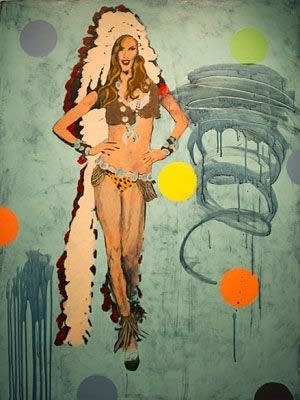Native American artists take back the headdress

When Dyani White Hawk Polk asked a group of artists for work for her exhibition "Make it Pop," she was looking for contemporary pieces responding to issues of the day.
"We've had somber exhibits, politically driven, fine art," says White Hawk Polk, sitting at her desk in All My Relations Gallery. "I wanted this to feel more playful and cutting edge, something that really speaks to our youth and people interested in pop culture as well as fine art lovers."
White Hawk Polk got what she was looking for; the colorful show reflects and comments on popular culture in a number of ways. Interestingly, two artists - Frank Buffalo Hyde and Cannupa Hanska Luger - chose to focus on an issue that has many Native Americans upset: the appropriation of Native Regalia by popular culture - in particular, the headdress.
[image]
Create a More Connected Minnesota
MPR News is your trusted resource for the news you need. With your support, MPR News brings accessible, courageous journalism and authentic conversation to everyone - free of paywalls and barriers. Your gift makes a difference.
[image]
Shown on the left: "In-Appropriate 3," a painting by Frank Buffalo Hyde responding to the use of a Native American headdress and jewelry on a Victoria's Secret model at a fashion show held on November 7, 2012, shown on the right.
White Hawk Polk says she wasn't surprised.
"It's always been an issue," reflects White Hawk Polk. "It's always been there, but this past year, year and a half, it's just been prolific."
Native Americans belong to many different tribes spread across Native North America. But the headdress, or war bonnet, is a universal symbol of great spiritual importance worn only by highly respected individuals.
So imagine their reaction to images of a Victoria's Secret model dressed in little more than feathers, turquoise jewelry and a leopard skin bikini. Or a Gwen Stefani music video in which she wears a fake braid, is tied up by men and shown writhing against a wall. Or Drew Barrymore's profile picture on Facebook, showing her wearing a headdress along with a Budweiser apron and giving the peace sign.
[image]
[image]
"Stereotype: The Barrymore" by Cannupa Hanska Luger
The piece was inspired by a photo Barrymore used as her Facebook profile photo, seen left.
Cannupa Hanska Luger says Barrymore's high profile picture is indicative of mainstream culture's continuous obsession with Native American iconography, and it has dangerous repercussions.
"Appropriation of cultural Regalia, such as the war bonnet ...causes sacred objects to lose their power when they are represented out of context," wrote Luger in his artist statement. "Adopting a culture, without context or understanding, drags the stories and history of that culture through the mud and bastardizes a sacred history for the 'kitsch' aspect of an object. These products create a mentality of disrespect toward the culture they were derived from. They do not honor the aesthetic--they steal and consume an identity."
In Luger's piece "Stereotype: The Barrymore," the trappings of Barrymore's photo - colorful chicken feathers - adorn a boombox, literally a "type of stereo." Dreamcatchers are placed where the speakers would be, and the red and white and pale blue trim makes a subtle reference to the Budweiser apron.
[image]
[image]
"In-Appropriate 1" by Frank Buffalo Hyde, inspired by a still from a Gwen Stefani video, seen left.
Frank Buffalo Hyde explains his paintings this way:
"At no other time in history have we (Natives) been so well equipped and educated, and so willing to fight these derogatory attacks on our images. So No Doubt removed their video and Urban Outfitters is still in court. This conflict of idea versus ideals can only be won when we own our own image. So we are and we do."
Dyani White Hawk Polk says Luger and Hyde's pieces serve to raise awareness while also poking fun at the absurdity of it all.
"Those of us who are really involved in our communities and also very in touch with mass media - it's something all of us have been watching all year long," says White Hawk Polk. "So of course our artists are responding to it artistically - it's an expression of our lived experiences."
[image]
White Hawk Polk sees it as the job of All My Relations to break down stereotypes of Native art while promoting a more accurate depiction of Native American culture.
"People expect the old," she says, "they expect native arts to remain frozen in this 1800s era. That's what has been continuously pushed in the media. They expect bead work, headdresses and buffaloes - things like that.
"Because that isn't provided in our education system, because native cultures in their true forms aren't really taught very often in public academic media - there's a huge gap in exposure."
In "Make It Pop," perhaps the best representation of contemporary native culture is found in Jodi Webster's piece "Wabansi Lakeside Chicago-Beyond Swag." In it a young boy sports a Chicago Bulls jersey and a traditional sash.
"It's just so real," smiles White Hawk Polk. "Those are our kids - they've got both going on. Their everyday love of the Chicago Bulls and contemporary fashion, and then they've got their participation in cultural events. Often you'll see kids on break from a powwow, and they'll have half their Regalia on with a hoodie thrown over it - that's just how it is. It's not one thing or another."
"Make It Pop" runs through May 4 at All My Relations Gallery in Minneapolis.